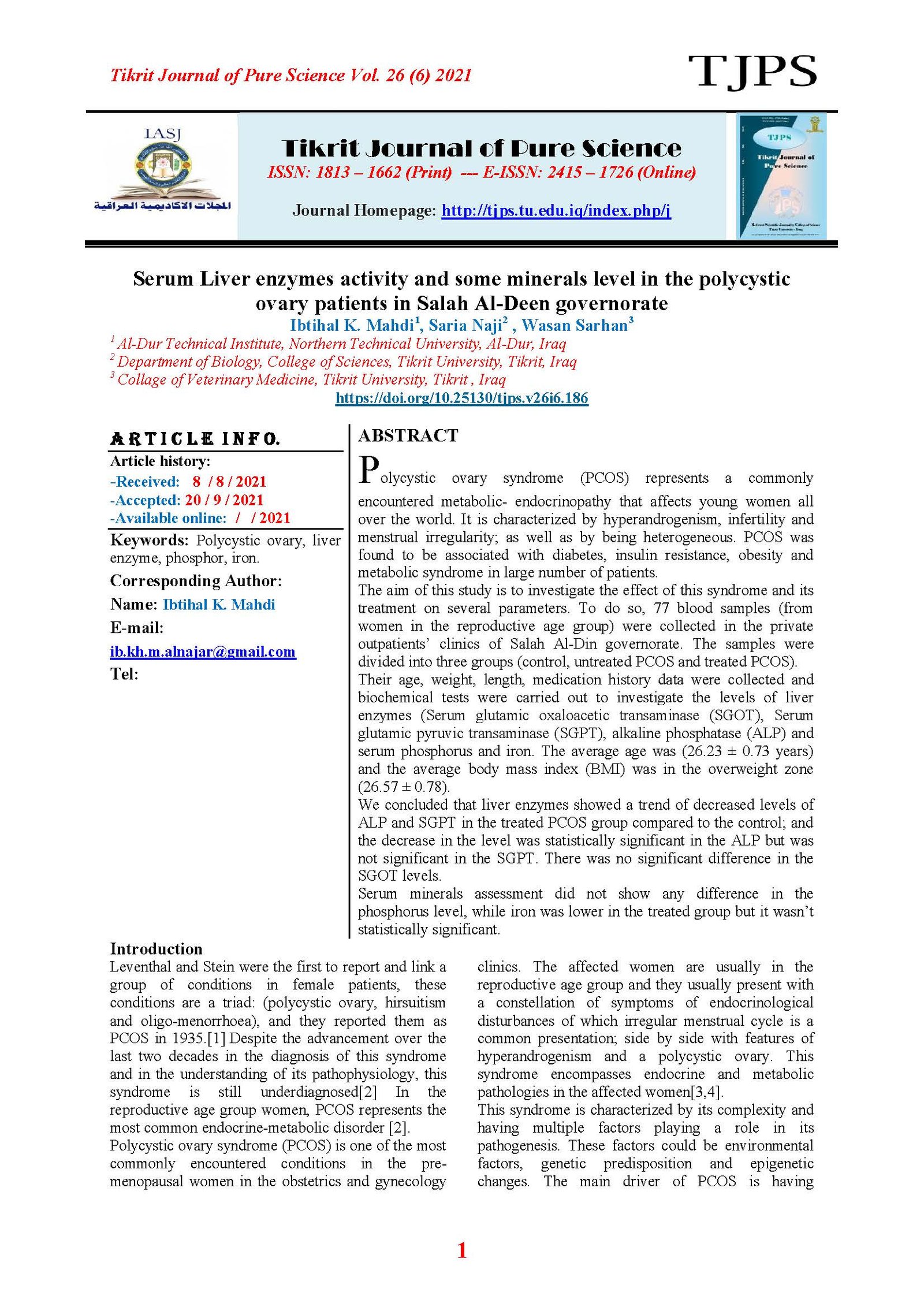Serum Liver enzymes activity and some minerals level in the polycystic ovary patients in Salah Al-Deen governorate
Main Article Content
Abstract
Polycystic ovary syndrome (PCOS) represents a commonly encountered metabolic- endocrinopathy that affects young women all over the world. It is characterized by hyperandrogenism, infertility and menstrual irregularity; as well as by being heterogeneous. PCOS was found to be associated with diabetes, insulin resistance, obesity and metabolic syndrome in large number of patients.
The aim of this study is to investigate the effect of this syndrome and its treatment on several parameters. To do so, 77 blood samples (from women in the reproductive age group) were collected in the private outpatients’ clinics of Salah Al-Din governorate. The samples were divided into three groups (control, untreated PCOS and treated PCOS).
Their age, weight, length, medication history data were collected and biochemical tests were carried out to investigate the levels of liver enzymes (Serum glutamic oxaloacetic transaminase (SGOT), Serum glutamic pyruvic transaminase (SGPT), alkaline phosphatase (ALP) and serum phosphorus and iron. The average age was (26.23 ± 0.73 years) and the average body mass index (BMI) was in the overweight zone (26.57 ± 0.78).
We concluded that liver enzymes showed a trend of decreased levels of ALP and SGPT in the treated PCOS group compared to the control; and the decrease in the level was statistically significant in the ALP but was not significant in the SGPT. There was no significant difference in the SGOT levels.
Serum minerals assessment did not show any difference in the phosphorus level, while iron was lower in the treated group but it wasn’t statistically significant.
Article Details

This work is licensed under a Creative Commons Attribution 4.0 International License.
Tikrit Journal of Pure Science is licensed under the Creative Commons Attribution 4.0 International License, which allows users to copy, create extracts, abstracts, and new works from the article, alter and revise the article, and make commercial use of the article (including reuse and/or resale of the article by commercial entities), provided the user gives appropriate credit (with a link to the formal publication through the relevant DOI), provides a link to the license, indicates if changes were made, and the licensor is not represented as endorsing the use made of the work. The authors hold the copyright for their published work on the Tikrit J. Pure Sci. website, while Tikrit J. Pure Sci. is responsible for appreciate citation of their work, which is released under CC-BY-4.0, enabling the unrestricted use, distribution, and reproduction of an article in any medium, provided that the original work is properly cited.
References
[1] Stein, I.F. and Leventhal, M.L. (1935). Amenorrhea associated with bilateral polycystic ovaries. American journal of obstetrics and gynecology, 29(2):181-91.
[2] Azziz, R. (2018).Polycystic Ovary Syndrome. Obstetrics and gynecology, 132(2):321-36.
[3] Ortiz-Flores, A.E.; Luque-Ramírez, M. and Escobar-Morreale, H.F. (2019).Polycystic ovary syndrome in adult women. Medicina clinica, 152(11):450-7.
[4] Sirmans, S.M. and Pate, K.A. (2013). Epidemiology, diagnosis, and management of polycystic ovary syndrome. Clinical epidemiology, 6:1-13.
[5] Lizneva, D.; Gavrilova-Jordan, L.; Walker, W. and Azziz, R. (2016).Androgen excess: Investigations and management. Best practice & research Clinical obstetrics & gynaecology, 37:98-118.
[6] Ruhl, C.E. and Everhart, J.E. (2010).Trunk fat is associated with increased serum levels of alanine aminotransferase in the United States. Gastroenterology, 138(4):1346-56, 56.e1-3.
[7] Vagvala, S.H. and O'Connor, S.D. (2018).Imaging of abnormal liver function tests. Clinical liver disease, 11(5):128-34.
[8] Peacock, M. (2021).Phosphate Metabolism in Health and Disease. Calcified tissue international, 108(1):3-15.
[9] von Drygalski, A. and Adamson, J.W. (2013).Iron metabolism in man. JPEN Journal of parenteral and enteral nutrition, 37(5):599-606.
[10] Coad, J. and Pedley, K. (2014).Iron deficiency and iron deficiency anemia in women. Scandinavian journal of clinical and laboratory investigation Supplementum, 244:82-9; discussion 9.
[11] Won, Y.B.; Seo, S.K.; Yun, B.H.; Cho, S.; Choi, Y.S. and Lee, B.S. (2021).Non-alcoholic fatty liver disease in polycystic ovary syndrome women. Scientific Reports, 11(1):7085.
[12] Cai, W.Y.; Gao, J.S.; Luo, X., et al. (2019). Effects of metabolic abnormalities, hyperandrogenemia and clomiphene on liver function parameters among Chinese women with polycystic ovary syndrome: results from a randomized controlled trial. Journal of endocrinological investigation, 42(5):549-55.
[13] Luo, X.; Yang, X.M.; Cai, W.Y., et al. (2020).Decreased Sex Hormone-Binding Globulin Indicated Worse Biometric, Lipid, Liver, and Renal Function Parameters in Women with Polycystic Ovary Syndrome. International journal of endocrinology, 2020:7580218.
[14] Li, M.; Tang, Y.; Lin, C.; Huang, Q.; Lei, D. and Hu, Y. (2017). Serum Macroelement and Microelement Concentrations in Patients with Polycystic Ovary Syndrome: a Cross-Sectional Study. Biological trace element research, 176(1):73-80.
